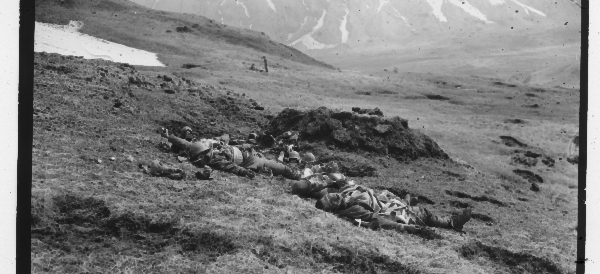
Sergeant George Gray stood on Attu Island’s Cold Mountain, looking down on the gulches and lower areas of Engineer Hill. His mission, as part of an unconventional band of army scouts known as Castner’s Cutthroats, was to spy on the enemy and report their position to the command post. But he was puzzled by what he saw: “odd-looking spurts and explosions.” Not trusting his eyes, he found a pair of binoculars. He peered through them, and the scene below came into focus.
Japanese soldiers were tapping hand grenades on their helmets to start the fuse, but instead of throwing them, they were holding them under their chins or against their stomachs. The odd-looking spurts were hands, arms, heads, and other body parts being blown apart by the grenades. Gray was not easily shocked—he’d seen plenty of dead bodies—but what he had just witnessed staggered him. It was “as strange an experience as anyone could think of,” he wrote near the end of the war. “Certainly the most bizarre of my lifetime.”
The May 29, 1943, scene was the macabre climax of the successful American fight to take back the Aleutian island of Attu from the Japanese, whose remaining soldiers opted to kill themselves rather than surrender. While one of the lesser-known victories in America’s Pacific Campaign, the Battle of Attu involved some of the bloodiest hand-to-hand fighting of World War II. It was also the centerpiece of the Allied effort to end Japan’s only campaign in the Western Hemisphere—one on American soil, no less. And it was notable for another reason: the motley but rugged group of U.S. Army scouts that included Gray—many of them native Alaskans accustomed to the area’s harsh climate—played an essential role in the American victory there.
The Japanese invasion of Alaska began on June 3, 1942, when carrier planes bombed Dutch Harbor, on the Aleutian island of Unalaska, where the United States had a small naval facility. Four days later, the Japanese invaded Attu and Kiska, on the westernmost portion of the 1,000-mile chain of isolated volcanic islands—an area with such violent weather and treacherous terrain that it has been called “the lonesomest spot this side of hell.”
Unopposed, they easily captured 47 American civilians on Attu and a 10-man navy weather team on Kiska. The Japanese believed that seizing the Aleutians, in an attack which ran parallel to the attack on Midway, would prevent the United States from building air bases there from which to attack Japan; help disrupt American shipping operations to the Soviet Union via the north Pacific; and provide potential air bases for an attack on the Russian Kamchatka Penninsula, in the event of war with the Soviet Union.
Soon after the Japanese landed in the Aleutians, however, they discovered what the U.S. military already knew: the hostile weather could be a formidable enemy. The sun rarely emerges from behind a thick and relentless fog. Rain, snow, and hurricane-force winds called williwaws are frequent, yet hard to predict, making mere survival a challenge.
Despite this brutal environment, the Aleut people had thrived there for 9,000 years. The Aleuts were highly skilled fishermen, spearing fish and harpooning seals and whales while expertly navigating the turbulent Bering Sea in animal-skin boats. On land they were adept hunters and trappers, particularly of the Arctic blue fox.
Colonel Lawrence V. Castner, intelligence chief of the U.S. Army’s Alaska Defense Command, took advantage of those survival skills after the army had given him the go-ahead to organize the 1st Alaskan Combat Intelligence Platoon in November 1941. The platoon, quickly dubbed the Alaska Scouts, was to specialize in commando-style fighting, intelligence gathering, mapping, and surveying. The idea was based on the success of the Philippine Scouts, a military unit created in 1901 to strengthen American forces in the Philippines. Castner’s father, Major General Joseph Castner, was one of its early commanders.
Colonel Castner, a masterful swordsman with a jagged scar running down his chin, recruited 66 men for the intelligence platoon, which would eventually be split into smaller units that would work and fight independently. The most crucial part of their job was to observe the enemy without being detected and send reports back to the commander, who would make strategic and tactical decisions based on their information.




